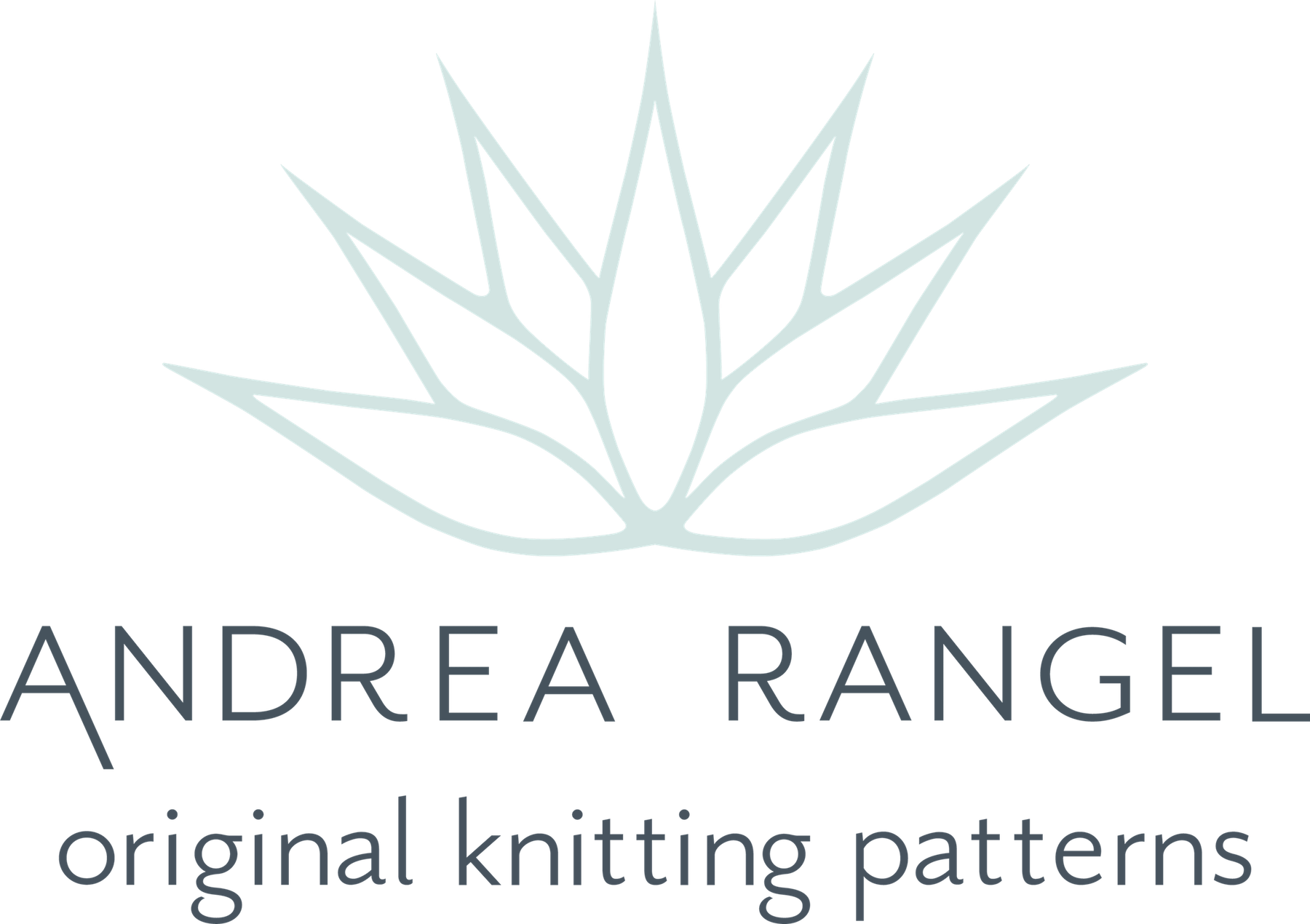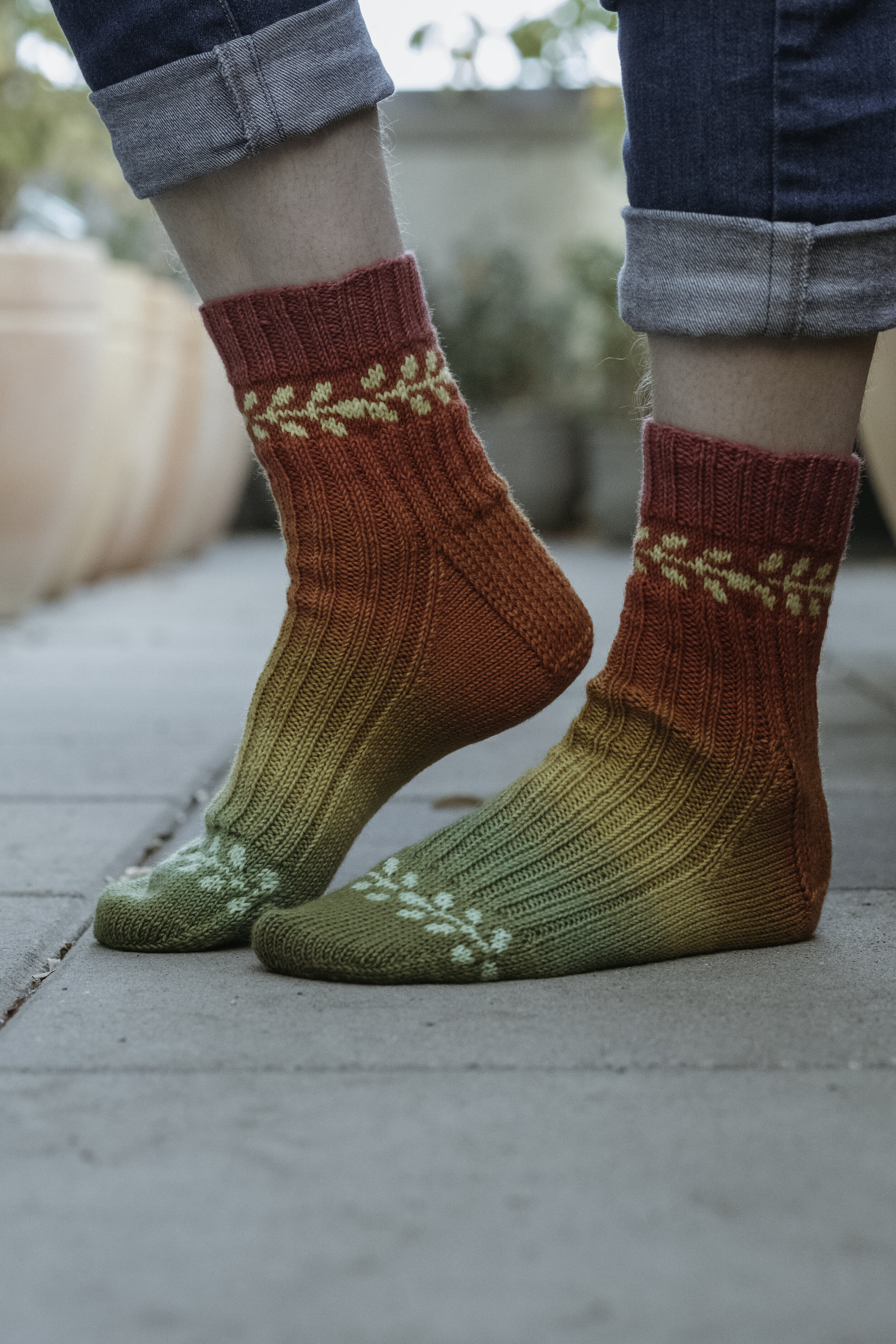FO: Wildflower Meadow Socks in Maple
If you’ve been following my collaborations with Gauge Dye Works, you’ve probably seen the Wildflower Meadow Socks, last summer’s sock pattern. When we made the pattern and yarn available to everyone this year, Gauge created a few new colourways and my favourite has to be Maple. You could definitely do other wonderful things with it (check out Gauge’s beautiful project), but just look at these gorgeous socks!
Andrea’s feet wearing socks in a green/yellow/orange/red gradient with leafy colourwork in contrasting colours at the toes and cuffs
The colourway name, Maple, really is perfect. I’ve got this wonderful big leaf maple tree right off my balcony and I feel like it keeps me company through all the seasons, so these socks are extra special. That colour fade is really perfect and I love the pop that the colourwork gives at the cuffs and toes.
Side view of Andrea’s feet in gradient socks. One of the socks fades from yellow to green about halfway up the foot. The other starts the green pretty close to the toe.
Andrea is standing on tip-toes in gradient socks. One heel is entirely orange and the other starts to fade from orange to yellow.
If you looked really carefully, maybe you noticed that my two socks aren’t perfectly identical. There’s less orange overall and the green starts a lot sooner on my left foot than my right. (These were worked top-down.) That’s because I made a mistake, but once I realized what I’d done, I decided to just go with it as an experiment. I’ll tell you about my mistake, but first it requires a tiny bit of background info.
When Gauge and I design these patterns and yarns together, we need to keep all the sizes in mind. We want the project to look just as perfect in the smallest size as in the largest, so we build in little buffers to make sure that the amount of yarn in each section works no matter what size you’re making. This is especially important for the heels of socks.
When you have a fade or stripes, you don’t want the pattern to be interrupted by the heel, which can easily happen. A heel flap, like I used for Wildflower Meadow, is worked over just half the stitches and it adds a little complication to a fade or stripe pattern because the knitter has to pick up stitches along the vertical edge of the flap. If the colour at the beginning of the heel flap isn’t the same as the colour used to pick up stitches along the edge of the flap for the gusset, you’ll get a really jarring colour-change at that spot, which isn’t ideal if you want that smooth fade. In order to avoid that in all the sizes, Gauge added an extra section of yarn in a colour that matches the colour you’ll be working in before and after you work the heel. That way, no matter how big the heel flap, the colour at the ankle, heel, and gusset will stay consistent before fading into the next colour. I think it’s a really smart solution if I do say so myself.
So back to my mistake. I made my first sock exactly according to my pattern in the second size (7”/18 cm/68 stitches). I pulled the heel flap colour from the centre of my ball of yarn and it worked perfectly! When I made the second sock, I was super confident and hardly followed my own directions at all. I was most of the way through the heel flap when I realized I had just kept knitting with the main yarn for my flap and hadn’t used the extra heel yarn at all. And for this size, it worked! The orange section was long enough that when I went to pick up the gusset stitches along the flap, it was still the same colour orange and my fade still looked great. But you can see that the colour changes much sooner on one sock than the other. I also used up all the green for the toe and had just started to get a little bit of the green/orange section at the end during my toe grafting.
My conclusion from this experiment is that for the smallest size, it would definitely work to just keep knitting with your main yarn for the heel flap, just being aware that you’ll get to the toe colour sooner. For the second size, the one I knit, it worked, but just barely. So if you try it, you’re risking that you’ll end up with a slightly orange toe tip. And for the largest two sizes, you really do need to use that extra yarn to make the fade work.
Andrea’s feet viewed from the back wearing gradient socks. One foot is flat and the other is pointed so you can see the bottom of the gradient as it fades from green to gold to orange.
Andrea doing a cute pointed toe pose in her gradient socks.
How the Yarn Works
Everything you need to make this pair of socks is included in one skein of yarn, which can seem kind of magical and unlikely when you get it in front of you if you haven’t tried it before. The pattern gives really clear visual and written instructions on how to divide up your yarn into separate balls in order to make the best use of it. The contrast colours for the colourwork are in the centre of the skein and the heel flap yarn is on either side of those contrast colours.
Here’s what the yarn looks like in the skein next to it divided up into separate balls for sock knitting. The colourway shown below is the original Wildflower Meadow one. All of what’s shown below on the right came from that one skein of yarn on the left.
A skein of yarn in shades of purple, blue, and green on a whit background.
Four balls of yarn in front of bright flowers. Two small ones in front are blue and green and larger ones behind are shades of purple, blue, and green.
You can get the yarn in four different colourways from Gauge, including the original Wildflower Meadow, Maple that I made, a very pretty blue/purple fade called Seastar, and the fun and summery Beachy. The pattern is available here on my website or on Ravelry.
I know it feels a little soon, but now might just be the perfect time to start your gift knitting plans and I think this would be a really perfect project to make for a non-knitter or give to a knitter to make themselves!
Happy knitting!
Four knitted gradient tubes on the left in bright colours and an image of Andrea holding a giant bouquet and wearing gradient purple, blue, and green socks with colourwork.












